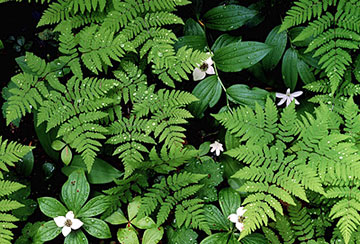Salinity Management Guide

Determining a factor for landscape plants other than turfgrass, part 2: Observation-based approach
Assigning a vegetative density factor, KD
The vegetative density factor (KD) in the equation for estimating KL accounts for the fact that different collective areas of leaves lead to different losses of water.
The less the collective area of leaves, the lower the loss of water. Assign the vegetative density factor as follows:
- Assign low value (0.5–0.9)
- if sparsely planted
- if single type of plant — for example, only trees or only shrubs
- if canopy of trees shades less than 70% of the ground
- if canopy provided by shrubs and ground covers shades less than 90% of the ground
- Assign average value (1.0)
- if characteristics indicating the need for adjustment downward are offset by characteristics indicating the need for adjustment upward
- if full plants one type only — for example, only full trees
- if only trees, with canopy shading 70% to 100% of the ground
- if only shrubs and ground covers, with canopy shading 90% to 100% of the ground
- if have mixture of plant types predominated by either trees with canopy shading 70% to 100% of the ground or shrubs and ground covers together shading 90% to 100% of the ground
- Assign high value (1.1–1.3)
- if densely planted
- if have mixture of types of plants — for example, trees, shrubs, and groundcovers
- if canopy of trees shades 70% to 100% of the ground
- if canopy of shrubs and ground covers shades 90% to 100% of the ground
- if canopy dense and have mixture of two or more types of plants of different heights — for example, tall trees, moderately tall shrubs, and low ground covers; adjust to high end of scale (1.3) if have three of more types of plants all of different height
| « Previous page | Next page » |